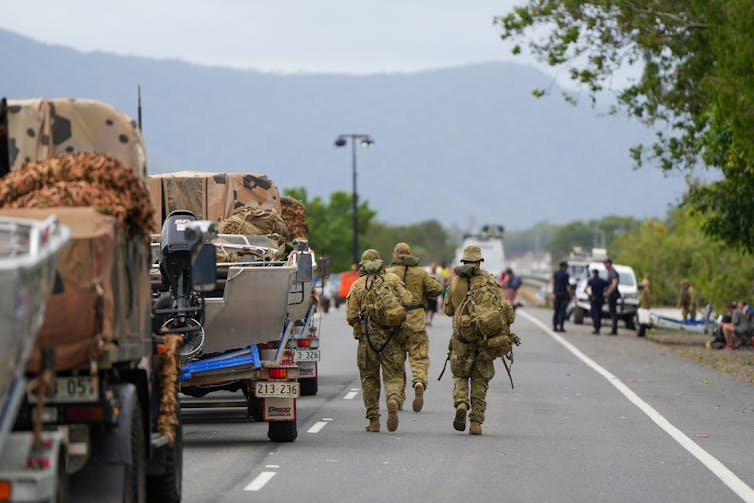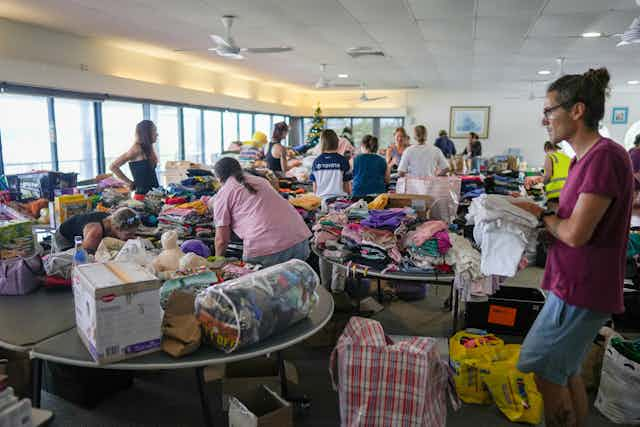As record-breaking floods in North Queensland ease and water levels recede, the focus now turns to the mop-up and recovery. Residents have been supporting each other through the flood crisis, such as processing donated goods, conducting welfare checks on neighbours and helping each other clean up homes.
Such community resilience in disasters is vital. Successive inquiries have shown we can’t rely solely on emergency services in large disasters. Crews can’t get to every community straight away, or provide support to every household that needs assistance.
Our research shows how communities can be supported to respond in a crisis – during the event, in the immediate aftermath and beyond.
As climate change worsens, extreme weather events are the new norm. Local community building and preparedness is now more important than ever.

Building disaster resilience
Volunteer numbers are declining nationally. However, when disaster strikes, people show a willingness to step forward and help their communities.
We have researched community-led responses to disasters in three locations in New South Wales – the Northern Rivers, Blue Mountains and Hawkesbury regions. We examined how community networks organised themselves during the response and recovery phases of the Black Summer bushfires (2019-20) and major floods (2020-22).
We found people leapt into action and helped one another: relaying early warning messages, distributing food when roads were cut and then cleaning up afterwards. They also provided emotional support when the going got tough. This included listening to and supporting flood-affected people who wanted to tell their story and start processing what had happened. Community members also supported elderly people when their at-home support services were cut off for extended periods.
In separate research in rural communities affected by drought, fire and flood, we found community-led collective action and planning can foster feelings of belonging and social connection. It can also help communities prepare for the broader consequences of climate change.
Community resilience in action
Many community-led resilience initiatives have emerged in the Northern Rivers region in the wake of successive disasters. They include Resilient Lismore, Resilient Uki, Wardell CORE, Together Pottsville, South Golden Beach Community Resilience Team, and Main Arm Disaster Recovery.
Examples of the activities flowing from these initiatives include:
- homegrown produce swaps
- community gatherings (such as festivals, barbeques and bushfire awareness talks)
- creating or joining formal local community groups
- creating community resilience plans
- bush regeneration projects
- improving emergency communications
- creating animal welfare plans for disasters.
One community program in Northern NSW was run by community organisation Plan C. The lead author of this article, Rebecca McNaught, is a board member and former consultant to the organisation and co-author Jean Renouf is the founder and chief executive. The program trained and supported more than 270 Northern Rivers residents across six local government areas. Most (80%) of these people were affected by floods in 2022 through loss of property or incomes, and 30% were directly threatened by bushfires in 2019-20.
The program covered the technical aspects of preparing for disasters, such as learning about the roles of fire, police and state emergency services. It also trained participants in disaster risks associated with bushfire, flood, tsunami and landslips.
Disasters can take a toll on mental health. Training people in how to look after themselves and each other in challenging times is important. The program teaches participants about the benefit of sharing stories about individual experiences, and guides participants in how to provide emotional support to someone who has experienced trauma. The program also covers concepts such as active listening, compassionate communication skills and self-care for both the helper and the person receiving support.
Participants are also mentored and connected to a network of community carers and responders who support each other and their communities to both recover from recent floods and fires and build resilience to future disasters.
The connection of community leaders across the Northern Rivers is essential. Through Whatsapp groups, leaders can express solidarity, share skills and resources, and support each other to work through the governance issues involving community organisations.
Read more: Why can floods like those in the Northern Rivers come in clusters?
The benefits are clear
Communities are important actors in preparing for and recovering from disaster, and should be supported to do this job well. And more robust research into community resilience programs is needed, to better understand what is working, who benefits and why.
Support for this work must come now, before the next disaster, so communities can pull together to withstand the challenges ahead.
The authors wish to acknowledge Emma Pittaway and Dr Johanna Nalau for their contributions to this article.

